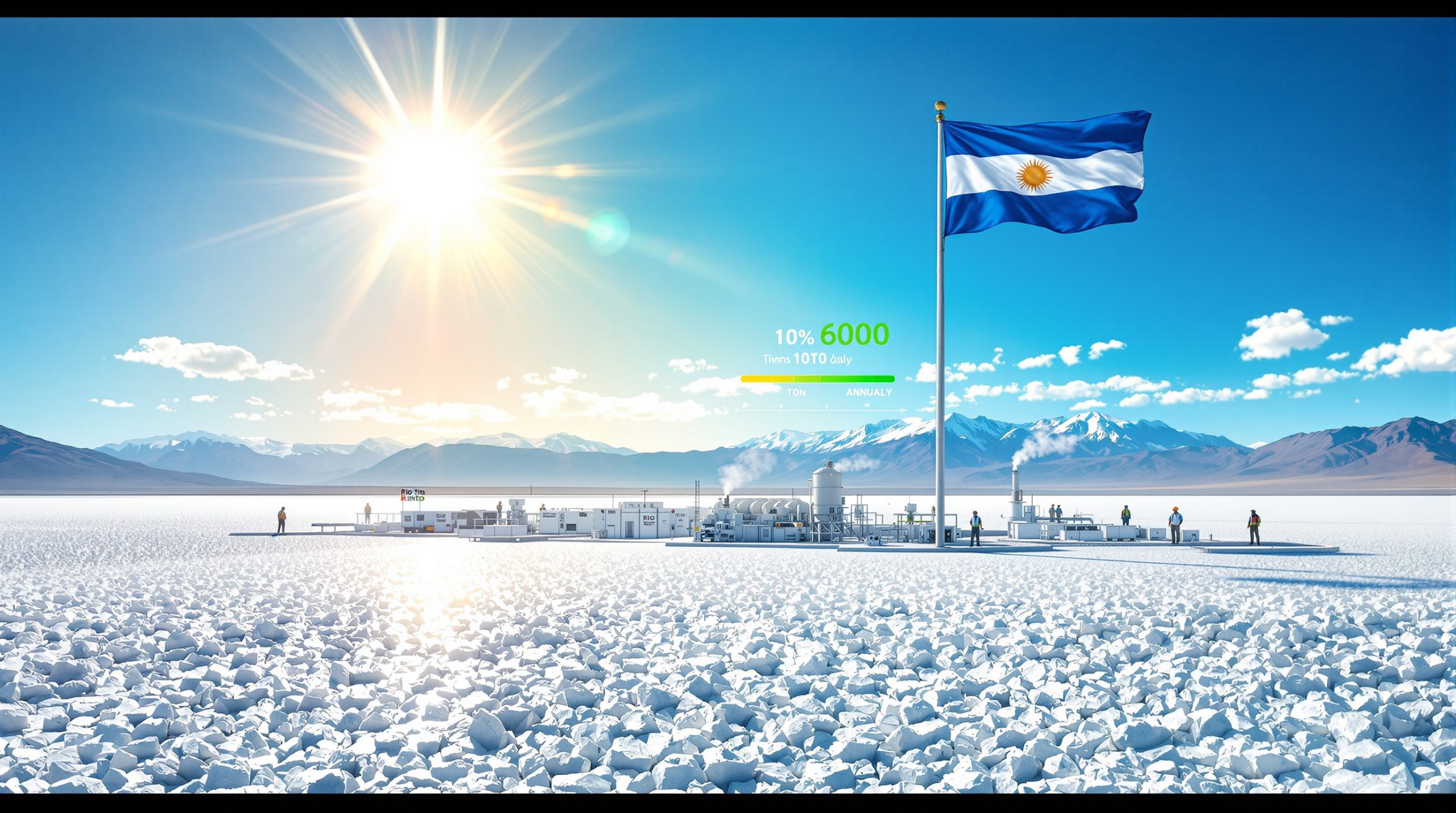Pentagon Strengthens US Rare Earth Supply Chain Through Strategic Investments
The US Department of Defense has embarked on a bold new strategy to secure America's rare earth supply chain, marking a significant shift in how the Pentagon approaches critical minerals energy security. In July 2025, the DoD finalized a multibillion-dollar deal to become the largest shareholder in MP Materials, America's premier rare earth mining and processing company.
"The US Department of Defense plans to continue working with rare earths companies to ensure diverse American supply of the critical minerals used across the economy," stated a senior defense official following the announcement of the landmark investment.
This strategic move represents more than just a financial transaction – it signals the Pentagon's recognition that rare earth elements have become as crucial to national security as traditional defense assets like aircraft carriers or missile systems.
What Are Rare Earth Elements and Why Do They Matter?
Rare earth elements (REEs) comprise a group of 17 chemically similar metallic elements, including the 15 lanthanides plus scandium and yttrium. Despite their name, most rare earths are relatively abundant in the Earth's crust – but finding economically viable concentrations is exceptionally challenging.
These minerals have become indispensable in modern technology due to their unique electronic, optical, and magnetic properties. A single F-35 fighter jet contains approximately 920 pounds of rare earth materials, while each Virginia-class submarine requires roughly 9,200 pounds.
The strategic importance of rare earths extends well beyond defense applications:
- Advanced Electronics: Smartphones, hard drives, and flat-screen displays
- Clean Energy Technology: Wind turbines, electric vehicles, and energy-efficient lighting
- Medical Equipment: MRI machines, surgical tools, and cancer treatment technologies
- Oil Refining: Catalysts for petroleum cracking and emissions control
The challenge lies not in the mining of these elements but in the complex separation and processing required to transform raw ore into usable materials. Currently, China controls approximately 85% of global rare earth processing capacity, creating a strategic vulnerability that the Pentagon aims to address through executive order on critical minerals.
Critical Applications in Defense Systems
Rare earth elements are essential components in numerous defense technologies:
| Defense System | Rare Earth Elements Used | Critical Function |
|---|---|---|
| Precision-guided munitions | Neodymium, samarium | Guidance systems, targeting |
| Night vision devices | Yttrium, europium | Image intensification |
| Radar systems | Yttrium, terbium | Signal amplification |
| Jet engines | Yttrium, erbium | Thermal barrier coatings |
| Laser targeting | Neodymium, yttrium | Beam focusing and stability |
What Does the MP Materials Partnership Include?
The Pentagon's investment makes the Department of Defense the largest shareholder in MP Materials, which operates the Mountain Pass mine in California – the only active rare earth mining and processing facility in the United States.
While exact financial details remain classified, industry analysts estimate the investment exceeds $2.5 billion. Beyond the equity stake, the Pentagon "also agreed to several financial backstop measures for the company," ensuring operational stability during market fluctuations.
Mountain Pass holds significant geological importance, containing an estimated 22 million tons of rare earth oxide equivalent, with particularly high concentrations of the most commercially valuable elements like neodymium and praseodymium. These two elements alone account for approximately 80% of the global rare earth magnet market.
Mountain Pass: America's Rare Earth Cornerstone
The Mountain Pass mine has a complicated history that reflects America's changing relationship with rare earth production:
- 1950s-1990s: Dominated global rare earth production
- 2002-2015: Operations suspended due to environmental concerns and Chinese competition
- 2017: Reopened under MP Materials ownership
- 2020-2024: Expanded mining operations but sent concentrated ore to China for processing
- 2025: Pentagon investment accelerates full vertical integration on American soil
MP Materials' three-stage development plan aims to restore complete rare earth supply chain independence:
"This partnership transforms America's rare earth capabilities from mining to magnets, ensuring that technologies critical to national security are built with domestically-sourced and processed materials." – MP Materials statement
How Does This Fit Into Broader US Critical Minerals Strategy?
The Pentagon's investment in MP Materials represents just one component of a comprehensive whole-of-government approach to securing America's critical mineral supply chains. This strategy operates under multiple legislative authorities:
- Defense Production Act Title III: Providing financial incentives for domestic production
- Critical Minerals List: Designation of 50 minerals essential to economic and national security
- 2023 Critical Infrastructure Protection Act: Establishing domestic content requirements
- Inflation Reduction Act: Tax credits for domestic rare earth processing
The Departments of Energy, Commerce, and Defense have established an interagency Critical Minerals Task Force to coordinate efforts across government. Their four-pillar strategy includes:
- Diversify Supply: Reducing dependence on single-source countries
- Develop Substitutes: Research into alternative materials
- Improve Recycling: Recovering rare earths from end-of-life products
- Domestic Production: Rebuilding America's extraction and processing capabilities
According to a recent Pentagon report, this comprehensive approach is essential for long-term minerals security.
What Challenges Do US Rare Earth Companies Face?
Despite the Pentagon's investment, American rare earth companies must overcome significant hurdles to establish a competitive domestic supply chain.
Technical Processing Complexities
The most formidable challenge lies in the sophisticated chemical processing required to separate rare earth elements from one another. These elements share nearly identical chemical properties, making separation extraordinarily difficult and costly.
A typical rare earth processing facility must:
- Mine and crush ore
- Concentrate rare earth content through flotation
- Leach rare earths using strong acids
- Perform solvent extraction (up to 1,000 stages for high purity)
- Convert separated elements into metals, alloys, or magnets
Each stage requires specialized knowledge that American industry largely surrendered to overseas competitors decades ago. Rebuilding this expertise demands significant investment in both infrastructure and human capital.
Economic Barriers to Competition
Chinese producers maintain substantial cost advantages through:
- Lower environmental compliance costs
- Government subsidies and tax incentives
- Vertical integration across the supply chain
- Economies of scale from decades of dominance
American producers must overcome a 15-30% cost disadvantage while simultaneously investing billions in new facilities. The Pentagon's financial backstop measures aim to bridge this gap during the critical establishment phase.
Environmental Considerations
Modern rare earth production must meet stringent environmental standards. The Mountain Pass mine previously closed partly due to environmental violations, including radioactive wastewater leaks. Today's operations must:
- Manage thorium and uranium byproducts safely
- Minimize water usage in desert environments
- Reduce acid consumption and neutralize waste
- Implement carbon capture to offset processing emissions
Disclaimer: Environmental compliance represents a significant portion of domestic production costs but is essential for sustainable operations and community acceptance.
How Will This Impact the Global Rare Earth Market?
The Pentagon's investment signals a major shift in global rare earth dynamics. Although the United States cannot immediately challenge China's market dominance, this strategic move creates meaningful diversification in the global supply chain.
Market analysts project several key impacts:
- Price Stabilization: Reduced market manipulation potential as supply diversifies
- Increased Transparency: U.S. production brings greater reporting and pricing visibility
- Innovation Acceleration: Competition drives technological improvements in processing
- Supply Chain Resilience: Decreased vulnerability to geopolitical disruptions
For global consumers of rare earth products, the emergence of a reliable alternative supplier provides strategic optionality, even if American production remains more expensive in the near term.
International Relations Implications
This strategic investment carries significant geopolitical implications:
- US-China Relations: Potential for increased tension as America challenges China's rare earth dominance
- Allied Cooperation: Opportunities for coordination with Australia, Canada, and European partners
- Resource Nationalism: May accelerate global trend toward treating minerals as strategic assets
- Technology Competition: Direct impact on advanced manufacturing supply chains
What Other US Rare Earth Companies Could Benefit?
The Pentagon's strategy extends beyond MP Materials to strengthen the entire domestic ecosystem. Several American companies are positioned to benefit from increased attention and investment:
Emerging Producers and Processors
- Energy Fuels: Developing rare earth processing capabilities at existing uranium facilities
- USA Rare Earth: Advancing the Round Top Mountain project in Texas
- Ucore Rare Metals: Focused on separation technologies through their RapidSX platform
- Texas Mineral Resources: Exploring development of heavy rare earth deposits
Technology Innovators
Several companies are pioneering alternative approaches to rare earth challenges:
- Urban Mining: Recovering rare earths from electronic waste
- Molten Salt Extraction: Novel processing methods with lower environmental impact
- Biomining: Using bacteria to extract and separate rare earth elements
- Synthetic Substitutes: Developing alternatives to rare earth magnets
These innovative approaches may ultimately prove more sustainable than traditional mining and processing methods. Such developments highlight the ongoing mining industry evolution taking place globally.
What Are the Next Steps for Pentagon-Industry Collaboration?
The Pentagon has outlined a phased approach to further strengthening America's rare earth capabilities:
Phase 1: Secure Mining and Basic Processing (2025-2027)
- Establish reliable ore extraction and concentration
- Develop basic separation capabilities for light rare earths
- Build workforce development programs at technical colleges
Phase 2: Advanced Separation and Metal Production (2027-2029)
- Master separation technologies for heavy rare earths
- Establish metal reduction facilities on American soil
- Develop specialized alloy production capabilities
Phase 3: Magnet Manufacturing and Component Integration (2029-2031)
- Scale up domestic neodymium magnet production
- Integrate rare earth components into defense supply chains
- Establish strategic reserves of critical materials
The Pentagon has indicated it will continue evaluating additional investment opportunities throughout this process, with particular emphasis on companies that can address specific supply chain vulnerabilities. This approach aligns with recent mineral production order initiatives.
FAQ About US Rare Earth Development
What prompted the Pentagon's increased interest in rare earths?
The Pentagon's focus on rare earth security intensified following several wake-up calls:
- China's 2010 embargo against Japan demonstrated supply chain vulnerability
- The 2019 trade war briefly raised the prospect of rare earth export restrictions
- COVID-19 pandemic exposed broader critical material supply chain fragility
- Advanced weapons systems increasingly require specialized rare earth components
These events highlighted that theoretical access to materials differs significantly from guaranteed supply during geopolitical tensions.
How does rare earth processing differ from mining?
While mining rare earths is relatively straightforward, processing presents exceptional challenges:
- Mining: Similar to conventional open-pit mining operations
- Processing: Requires up to 1,000 chemical separation stages
- Expertise Gap: America retains mining knowledge but lost processing expertise
- Capital Intensity: Processing facilities cost 5-10x more than mining operations
- Timeline Disparity: Mines can open in 3-5 years; processing plants take 7-10 years
This processing complexity explains why China maintained its dominant position despite having only about one-third of global rare earth reserves.
What role do rare earths play in defense applications?
Rare earth elements have become indispensable in modern military technology:
- Precision Guidance: Neodymium magnets enable miniaturized motors in guidance systems
- Stealth Technology: Radar-absorbing materials incorporate rare earth compounds
- Laser Systems: Yttrium-aluminum-garnet crystals form the heart of targeting lasers
- Communications: Signal amplification relies on rare earth components
- Night Vision: Phosphors containing europium and yttrium enable image intensification
The Pentagon estimates that a single F-35 fighter contains over 920 pounds of rare earth materials.
How might this impact US relations with current rare earth suppliers?
The Pentagon's investment strategy carefully balances diplomatic considerations:
- Emphasizes supply diversification rather than complete independence
- Maintains cooperation with allied nations like Australia and Canada
- Avoids explicitly antagonistic language toward Chinese suppliers
- Creates leverage without threatening immediate market disruption
This measured approach reflects recognition that abrupt changes could destabilize global markets and trigger countermeasures.
Future Outlook for US Rare Earth Security
Achieving meaningful rare earth security requires sustained commitment beyond initial investments. Industry analysts project that establishing a resilient domestic supply chain will require:
- $5-7 billion in capital investment over the next decade
- 5,000-7,000 specialized technical jobs in mining, processing, and manufacturing
- 10+ years to achieve full production capacity across all rare earth elements
- Public-private partnerships to manage market volatility during development
Disclaimer: These projections represent estimates based on current market conditions and technology. Actual timelines and costs may vary significantly depending on technological developments, regulatory changes, and market dynamics.
The Pentagon's rare earth strategy represents a significant pivot in how America approaches strategic material security. By becoming an active participant rather than a passive consumer in the rare earth market, the Department of Defense is taking concrete steps to ensure that the minerals powering tomorrow's defense systems remain securely within America's supply chain. Many experts believe this approach could serve as a model for establishing a broader critical minerals strategic reserve to further strengthen national security.
Ready to Profit from Major Mineral Discoveries?
Discovery Alert's proprietary Discovery IQ model instantly notifies investors about significant ASX mineral discoveries, transforming complex data into actionable insights for both immediate trading opportunities and long-term investments. Explore why major mineral discoveries can lead to substantial market returns by visiting Discovery Alert's dedicated discoveries page and begin your 30-day free trial today.




